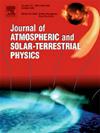Statistical study of low-latitude E-region irregularity occurrence rate based on Qujing VHF radar observations
IF 1.9
4区 地球科学
Q3 GEOCHEMISTRY & GEOPHYSICS
Journal of Atmospheric and Solar-Terrestrial Physics
Pub Date : 2025-02-19
DOI:10.1016/j.jastp.2025.106479
引用次数: 0
Abstract
Based on the Quing VHF radar (25.6°N, 103.7°E, magnetic latitude 16.1°N, magnetic longitude 177.0°E) measurements from 2016 to 2020, the morphological characteristic of low-latitude E-region field-aligned irregularities (FAIs) was reported in this work. Statistical results show that the occurrence of Qujing E-region irregularities highly depends on both season and local time. The occurrence rate of E-region FAIs peaks in the summer, with the lowest occurrence rates in autumn and winter, and primarily occurs at night. The Doppler spectrum suggests that the Qujing E-region FAI echoes are mainly characterized by type II echoes. Quantitative analysis of both the activity of the Es layer and E-region FAI structures was also conducted. It is found that the occurrence of low-latitude E-region FAIs is closely correlated with the enhanced electron density structures inherent in the local Es layers. Given the weak electric field at low and mid-latitudes, neutral winds controlling ion drift likely trigger gradient drift instability above the Es layer, leading to small-scale irregularities in Qujing. Further investigation is required to understand the influence of the medium-scale traveling ionospheric disturbance on the occurrence rate of ionosphere E-region FAIs in low latitudes.
基于曲靖VHF雷达观测的低纬度e区不规则率统计研究
本文基于2016 - 2020年青海VHF雷达(25.6°N, 103.7°E,磁纬16.1°N,磁经177.0°E)观测数据,报道了低纬度E区场向不规则(FAIs)的形态特征。统计结果表明,曲靖e区异常的发生与季节和当地时间都有很大的关系。e区FAIs的发生率在夏季最高,秋冬季发生率最低,主要发生在夜间。多普勒频谱分析表明曲靖e区FAI回波以II型回波为主。定量分析了Es层和e区FAI结构的活性。发现低纬度e区fai的出现与局域e层固有的电子密度结构增强密切相关。由于低纬度和中纬度地区电场弱,控制离子漂移的中性风可能引发Es层以上的梯度漂移不稳定,导致曲靖地区出现小尺度不规则。中等尺度电离层扰动对低纬度地区电离层e区fai发生率的影响有待进一步研究。
本文章由计算机程序翻译,如有差异,请以英文原文为准。
求助全文
约1分钟内获得全文
求助全文
来源期刊

Journal of Atmospheric and Solar-Terrestrial Physics
地学-地球化学与地球物理
CiteScore
4.10
自引率
5.30%
发文量
95
审稿时长
6 months
期刊介绍:
The Journal of Atmospheric and Solar-Terrestrial Physics (JASTP) is an international journal concerned with the inter-disciplinary science of the Earth''s atmospheric and space environment, especially the highly varied and highly variable physical phenomena that occur in this natural laboratory and the processes that couple them.
The journal covers the physical processes operating in the troposphere, stratosphere, mesosphere, thermosphere, ionosphere, magnetosphere, the Sun, interplanetary medium, and heliosphere. Phenomena occurring in other "spheres", solar influences on climate, and supporting laboratory measurements are also considered. The journal deals especially with the coupling between the different regions.
Solar flares, coronal mass ejections, and other energetic events on the Sun create interesting and important perturbations in the near-Earth space environment. The physics of such "space weather" is central to the Journal of Atmospheric and Solar-Terrestrial Physics and the journal welcomes papers that lead in the direction of a predictive understanding of the coupled system. Regarding the upper atmosphere, the subjects of aeronomy, geomagnetism and geoelectricity, auroral phenomena, radio wave propagation, and plasma instabilities, are examples within the broad field of solar-terrestrial physics which emphasise the energy exchange between the solar wind, the magnetospheric and ionospheric plasmas, and the neutral gas. In the lower atmosphere, topics covered range from mesoscale to global scale dynamics, to atmospheric electricity, lightning and its effects, and to anthropogenic changes.
 求助内容:
求助内容: 应助结果提醒方式:
应助结果提醒方式:


